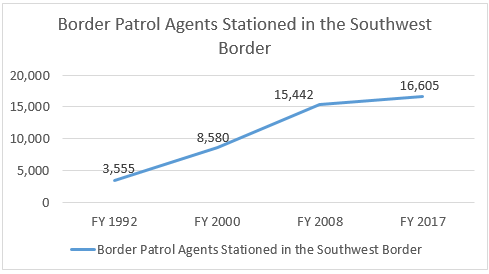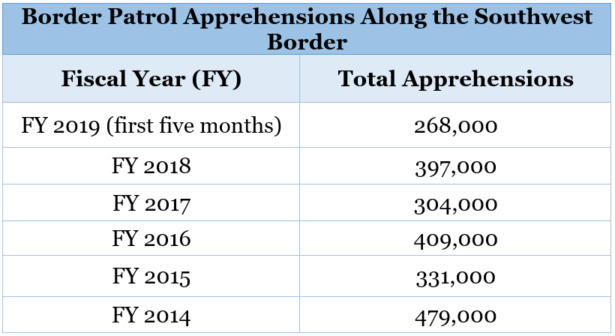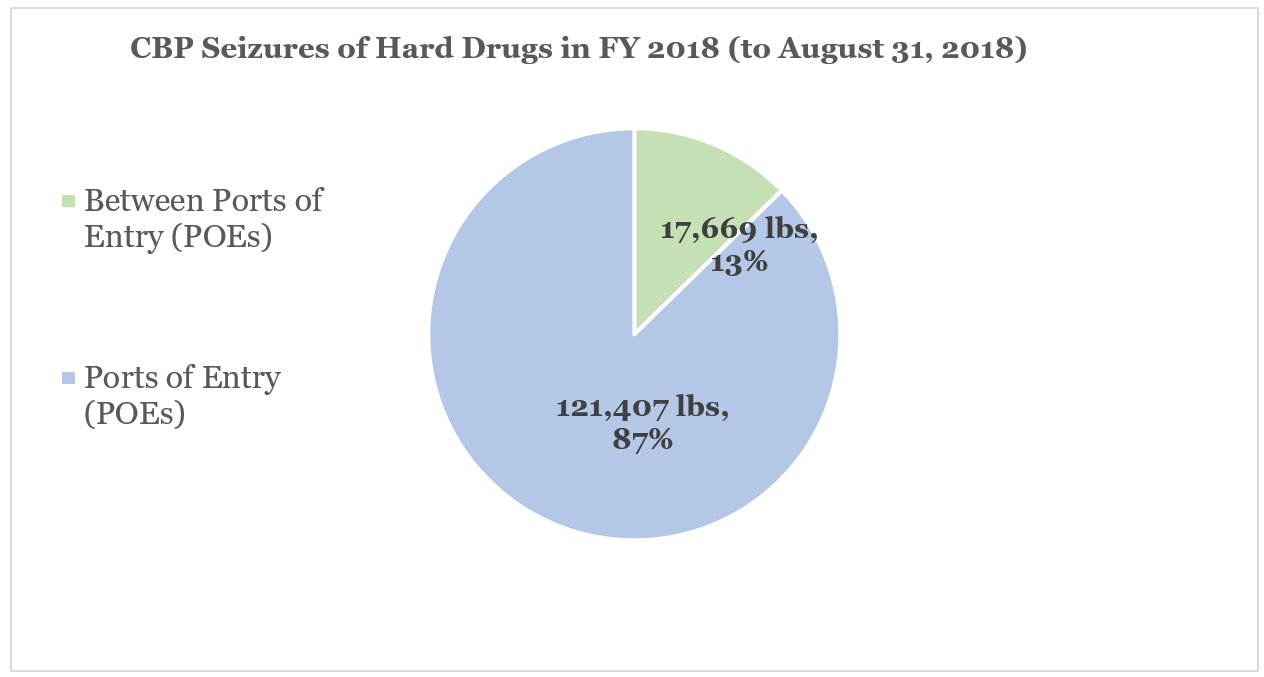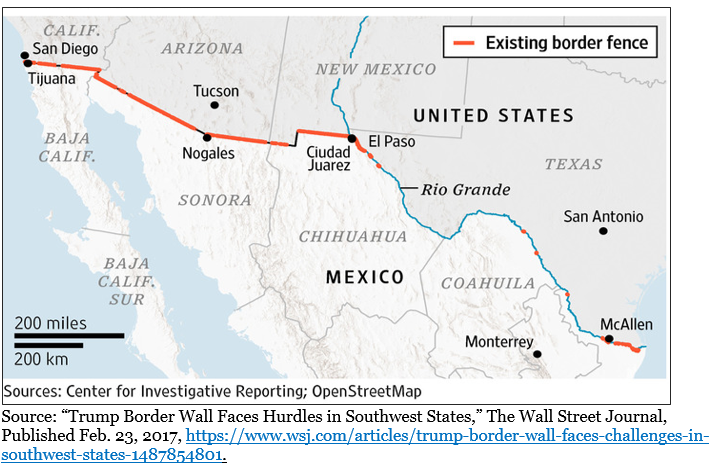How secure is the Southwest border?
America’s Southwest border has never been more secure. Following the passage of the Secure Fence Act in 2006, the U.S. built nearly 700 miles of physical barriers along the 2,000-mile Southwest border, an all-time high, with the rugged terrain and the Rio Grande acting as natural barriers in other areas.
In addition to fencing, U.S. Customs and Border Protection (CBP) also relies heavily on technology to secure the Southwest border. Such technology typically costs less than constructing physical barriers, is less intrusive, and serves as a better force multiplier. CBP utilizes a host of border security technologies, including fixed towers, mobile surveillance systems, remote video surveillance systems, thermal imaging systems, radiation portal monitors, ground sensors and license plate readers, as well as operating Predator B unmanned aerial drones in the Southwest border region.
To complement these physical barriers and technology, the Border Patrol stationed 16,605 agents in the Southwest border region in fiscal year (FY) 2017 – the latest figures available – nearly double the number in FY 2000. In addition, between FY 2000 and FY 2017, Congress increased the Border Patrol’s budget approximately 380 percent from about $1.1 billion to nearly $3.8 billion.

Are border crossings along the Southwest border increasing or declining?
Border crossings have declined to near-record low levels in recent years. The number of apprehensions along the Southwest border between ports of entry was fewer than 304,000 in FY 2017, the lowest number since FY 1971, almost fifty years ago. This represented a decline of approximately 25 percent from FY 2016 levels (409,000 border apprehensions) and a decline of more than 80 percent from the record-high levels of FY 2000 (1.6 million border apprehensions).
There has been an increase in border crossings and apprehensions in FY 2018 and in the first five months of FY 2019, but the number of people attempting to enter the U.S. is still far below the all-time high levels of the early 2000s. The Border Patrol apprehended an estimated 397,000 people in FY 2018, a 31 percent increase from FY 2017 levels (304,000 apprehensions) and a decline of 75 percent from FY 2000 levels (1.6 million apprehensions). In the first five months of FY 2019, the Border Patrol apprehended 268,000 people, a 95 percent increase over the same period in FY 2018 (137,000 apprehensions) and a 43 percent increase over the same period in FY 2017 (187,000 apprehensions). That said, the number of people attempting to enter the U.S. in FY 2019 is still consistent with the lower levels of the mid-to-late-2010s.

The most recent data available also shows each Border Patrol agent along the Southwest border apprehended on average about 3 migrants in the first five months of FY 2019, an increase above FY 2018 (approximately 2 migrants per month), but far below FY 2000 levels (approximately 16 migrants per month), when a much smaller Border Patrol faced a much larger number of border crossers.
How much does each Border Patrol apprehension cost the American taxpayer?
Approximately $10,800 per apprehension. With the significant increase in Border Patrol personnel and a large decrease in unlawful border crossings over the past two decades, the average annual number of apprehensions made by each Border Patrol agent dropped from 182 in FY 2000 to only 24 in FY 2018. At the same time, the Border Patrol’s budget increased from about $1.1 billion in FY 2000 to $3.8 billion in FY 2017 and to nearly $4.3 billion in FY 2018, a record-level of funding.
As the number of people crossing the border has declined, the amount spent by the Border Patrol per apprehension at the nation’s borders has increased considerably. While U.S. taxpayers spent an average of $656 per Border Patrol apprehension in FY 2000, that number rose to $10,831 in FY 2018 – an increase of about 1,650 percent. The marginal cost of an additional border apprehension has skyrocketed, even as the overall trend of unlawful crossings has gone down, suggesting that a shift in border security policies could yield significant savings to taxpayers.
Does separating parents from children deter border crossings?
The data suggests it does not. The federal government’s decision to implement a new “zero-tolerance” policy to criminally prosecute virtually all migrants crossing the Southwest border between ports of entry without authorization, including parents accompanied by their children, led to the separation of about 2,650 children from their parents between April and June 2018. Yet, CBP figures show that the number of people traveling in family units apprehended at the Southwest border remained virtually unchanged while the policy was in place, declining from 9,649 in April 2018 to 9,258 in July 2018 (a decrease of only 4.2 percent). The modest decline in apprehensions and increase in share of those traveling in family units suggests that the federal government’s “zero-tolerance” policy only had a limited effect in deterring families from coming to the U.S.

The data above suggests that the threat of separating parents and children is unlikely to deter a parent whose children’s lives are at risk. Families facing threats of violence or murder from gangs, drug cartels, and transnational criminal organizations may do whatever it takes to flee to safety.
Despite an overall decrease in the number of migrants crossing the Southwest border since the all-time high levels of the early 2000s – mostly as a result of the decrease in the number of Mexican migrants coming to the U.S. – families and children seeking asylum from the three neighboring Northern Triangle countries of Honduras, Guatemala and El Salvador continue to arrive at the U.S. border. Those countries consistently rank among the most violent countries in the world, possessing the world’s highest murder rates. The administration’s new policies aimed at deterring these families are bound to fail, given the immense danger these families face by remaining in their home countries.
Would constructing a 2,000-mile border wall be an effective use of resources?
No. Building a 2,000 mile border wall would be an expensive endeavor without being particularly effective. The cost of building a wall along the Southwest border has been estimated to range from $21.6 billion to $31.2 billion, not including the cost of maintaining the wall and other physical barriers over the years. Before appropriating that level of funding, Congress should consider whether a wall is the most appropriate solution in a particular area.
Previously, as mandated by Congress in 2006, the Border Patrol field office commanders identified a total of 652 miles of the Southwest border where fencing and barriers were operationally necessary to secure the border and prevent border crossings. By 2015, the United States had built border fencing along 654 miles of the Southwest border, including approximately 350 miles of primary pedestrian fencing, 300 miles of vehicle fencing, 36 miles of secondary fencing behind the primary pedestrian fencing and 14 miles of tertiary pedestrian fencing behind the secondary fence. The fencing was primarily built in areas where it was determined that physical barriers were needed to prevent border crossings and accounting for factors like varying terrain, such as mountain ranges and rivers, that act as natural barriers.
Constructing a wall or fence along the rest of the 2,000 miles of the Southwest border region would not be cost effective. Instead, a 2,000 mile wall would be a one-size fits all solution for a diverse region, which runs along riverbanks, through remote deserts, rugged terrain, marshlands, and hill country. In addition, building a fence along the entire Southwest border would require the government to seize thousands of acres of private land via eminent domain, particularly in Texas, where many families have privately owned the land for generations.
On July 2018, the Government Accountability Office (GAO) released a report that found CBP selected locations along the Southwest border in December 2017 to construct physical barriers without fully assessing where they were needed and without accounting for factors like varying terrain and land ownership. The report notes that DHS “faces an increased risk that the Border Wall System Program will cost more than projected, take longer than planned or not fully perform as expected.”
It is important that Congress direct DHS, after consultation with local communities, to determine whether a fence or wall is the most appropriate option to secure any area of the border. For those areas DHS does not deem appropriate for fencing, CBP can attain operational control of the border areas through the use of technology and its current Border Patrol agents.
Are there obvious investments in border security resources that would be effective?
Yes, investments in ports of entry are much-needed and would be an effective use of funds. Congress should invest in the CBP Office of Field Operations (OFO), which oversees the flow of commerce and immigrants at all 328 ports of entry in the nation. CBP OFO currently has a staffing shortage of at least 3,811 port of entry officers, representing a vulnerability in our country’s border security. CBP also found in 2014 that adding a single CBP OFO officer to a port of entry would result in annual benefits of a $2 million increase in our country’s Gross Domestic Product (GDP), $640,000 saved in opportunity costs, and 33 jobs added to the economy, because it would help speed the flow of commerce.
What is the best way to reduce drugs smuggling across the Southwest border?
Through focusing on investments at ports of entry. CBP statistics show that 81 percent of hard drugs intercepted along the Southwest border between FY 2012 and FY 2016 were seized at ports of entry. More recently, in the first eleven months of FY 2018, CBP OFO officers seized 121,407 pounds of cocaine, heroin, methamphetamine and fentanyl at ports of entry, compared to 17,669 pounds seized by the Border Patrol between ports of entry.
Congress must invest in infrastructure and staffing at ports of entry to help curtail drug trafficking. Investments in border security between ports of entry, including investments in physical barriers and more Border Patrol agents, will not stop dangerous drugs from entering communities in America.

What other policies are effective in promoting border security?
Carrizo cane/salt cedar plant eradication, the use of body-worn cameras, and immigration reform. A new program to eradicate invasive plants that block the view of Border Patrol agents would be a cheap and effective way to improve border security. A federal program to eradicate the invasive and non-native carrizo cane and salt cedar plants along the Rio Grande Valley in Texas would provide the Border Patrol with greater visibility agents and access to the Rio Grande.
In addition, investing in funds to implement the use of body-worn camera technology at CBP would improve government transparency and safety at the border. The evidence indicates that body-worn cameras lead, in one study, to 88 percent fewer complaints against officers and fewer assaults, creating a win-win solution for the public and law enforcement.
Finally, leading national security officials agree that having a 21st century immigration system that promotes safety and security benefits American workers and our economy, and provides earned legalization for otherwise law-abiding undocumented immigrants living in the U.S. would have the most significant impact in promoting security at our borders. Reforming our existing broken immigration system would ensure that future labor needs are fulfilled by our legal immigration system and permit undocumented immigrants living in the U.S. to come out of the shadows to fully and legally participate in the economy, reducing the need for migrants to cross the Southwest border without authorization and allowing CBP and other law enforcement agencies to focus on apprehending individuals with criminal records.




